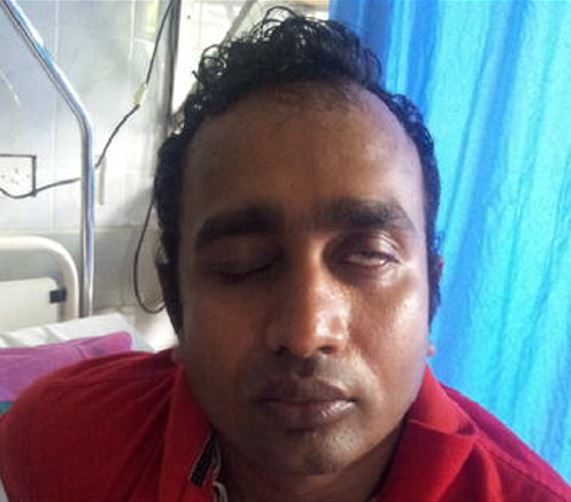Playlist
Show Playlist
Hide Playlist
AIDP: Rapidly Progressive Ascending Paralysis
-
Slides Acute Inflammatory Demyelinating Polyneuropathy.pdf
-
Download Lecture Overview
00:01 So let's talk a little bit more about the rapidly progressive ascending neuropathies or ascending paralysis. 00:07 The typical presentation is several days of subacute progressive neuropathy. 00:12 There's prominent weakness. 00:13 Patients may have foot drop, weakness, difficulty walking, there's often some sensory complaints: numbness, tingling, burning paraesthesia's but they're not near as prominent as the weakness or motor dysfunction. 00:26 And some other notable symptoms are back pain is not uncommon. 00:30 And that should not point towards a spinal cord disorder in a patient presenting with this pathology. 00:37 There are some key clinical questions that we ask when evaluating patients presenting with acute rapidly progressive ascending paralysis. 00:45 One is, is this neuropathy? Is that a nerve problem or a spinal cord problem or something else? The second is if it's a nerve problem? Is it inflammatory? And the third is, is it demyelinating or axonal? So let's walk through each of those steps in the evaluation of these patients. 01:01 First, let's talk about signs and symptoms of Guillain-Barré Syndrome at presentation and diagnosis. 01:07 Patients typically present with symmetrical weakness starting in the legs. 01:11 At diagnosis this is present to 90% of patients 10% also starting to involve. weakness in the arms and face. 01:21 There's a need for ventilatory support and 10 to 30% of patients, face and oropharyngeal weakness can be seen in 50%. 01:29 Ocular motor weakness in 15% of patients. 01:32 Areflexia is extremely common. 01:34 90 to 100% of patients will develop areflexia and that should point squarely to a peripheral nerve disorder as opposed to another localization. 01:43 Pain is not uncommon in two thirds of patients, but it's usually not prominent, and dysautonomia is extremely common. 01:49 One of the things we need to watch out for in these patients. 01:53 So these are some of the typical signs and symptoms that we see in patients presenting with Guillain-Barre. 01:58 Now, let's talk about the typical description of acute inflammatory demyelinating polyneuropathy. 02:04 or Guillain-Barre syndrome. 02:06 There are a few features that I want you to hear and that we evaluate in patients. 02:10 First is that this appears acute and onset. 02:14 Now oftentimes, it's not acute within hours, or minutes, or a day, but more subacute and onset, but it's really rapid, and it has that flavor of being a rapidly progressive problem. 02:25 The typical onset of symptoms is subacute over one to three days. 02:30 It is rapidly progressive. 02:32 The typical Nadir is around three to four weeks, and then it plateaus. 02:36 This is a polyneuropathy. 02:38 So we see symptoms that affect all of the nerves, both arms and legs, often symmetrically, and it can be postinfectious, after it classically after a Campylobacter jejuni infection, but other infections or vaccinations can lead to this problem. 02:53 And here we're looking at a graph of some of the things that can occur classically in patients with AIDP or Guillian-Barre. 03:00 The first is this antecedent infection. 03:03 You can see when that occurs, often a couple of weeks before the onset of symptoms, the patients begin with no weakness. 03:09 And really quickly over time. 03:11 rapidly and progressively patients develop severe weakness, many ultimately with paralysis. 03:18 Over time, there's development of anti-neuronal, anti ganglioside antibodies, and it's thought that this infection may set off an immune response and the develop of these anti neuronal, anti ganglioside antibodies that is contributing to the immune attack. 03:33 The attack nadirs within about four weeks and classically within four weeks, and then patients develop spontaneous recovery over weeks to months, and sometimes even years. 03:46 There are a few other features that we want to think about with AIDP. 03:50 The second is that it is an inflammatory disorder. 03:53 This is an autoimmune or immune mediated attack on the nerves. 03:57 This results in the ascending weakness as well as the early diffuse areflexia which indicates an immune mediated proximal polyneuropathy, which we call a polyradicular neuropathy. 04:08 This disorder reaches its nadir of symptoms at 14 days after onset and can progress to requiring intubation secondary to respiratory depression from respiratory muscle weakness. 04:24 So if we've proven that this is a neuropathy, or we're strongly suspicious of a neuropathic disorder, our second question is, is the neuropathy, is this polyneuropathy inflammatory? And here we turn to our lumbar puncture. 04:37 Lumbar puncture is one of the most important tests for evaluating patients who are presenting with a rapidly progressive ascending paralysis, and we're looking for signs of an inflammatory LP. 04:48 When we perform an LP or CSF analysis, we typically look at blood, white blood cell count or cell count, glucose and protein. 04:56 The classic inflammatory LP as you can see here is normal to maybe slightly elevated cells or a pleocytosis and significantly elevated protein. 05:06 The goal of the LP is to prove inflammation and exclude infection. 05:11 Some of the things on the differential diagnosis for AIDP or Guillain-Barre, or West Nile polyradiculitis, CMV polyradiculitis, and those conditions would prevent with an infectious LP. 05:25 Our next step is to evaluate the part of the nerve that's involved. 05:28 Classically, Guillain-Barre affects the myelin. 05:31 But there are some variants that can affect the axon and have a poor prognosis. 05:35 And we use the nerve conduction and EMG studies to confirm that the problem is neuropathic to confirm that the problem is inflammatory, and to evaluate the part of the nerve that's involved. 05:46 So our question on the nerve conduction study is, do we see a demyelinating pattern with prolonged latency and reduced conduction velocity? Or an axonal, pattern where there's reduced amplitude of the responses? Our EMG can look at the timing of this condition. 06:00 Do we see acute changes and spontaneous activity or more subacute to chronic changes that would be a typical for the typical acute Guillain-Barre. 06:09 And the goal is to determine whether this is a demyelinating or axonal disorder? In terms of the workup, in addition to LP and nerve conduction, we may consider MRI of the spine and patients who present with atypical features where we're worried about a myelopathy. 06:27 Ultimately, lumbar puncture is the most important tests to evaluate these patients and nerve conduction study an EMG is often used for confirmation.
About the Lecture
The lecture AIDP: Rapidly Progressive Ascending Paralysis by Roy Strowd, MD is from the course Acute Inflammatory Demyelinating Polyneuropathy (AIDP).
Included Quiz Questions
Which of the following is consistent with acute inflammatory demyelinating polyneuropathy?
- It typically begins one to three days after an infection or vaccination.
- It is typically unilateral.
- It typically begins in the hands.
- Its sensory deficit is typically greater than its motor deficit.
- It typically progresses over months to years.
Generalized areflexia is a common feature of which of the following?
- Guillain-Barré syndrome
- Myasthenia gravis
- Diabetic polyneuropathy
- Spinal cord injury
- Herniated disk
Which of the following is most likely seen with acute inflammatory demyelinating polyneuropathy?
- An inflammatory picture in the cerebrospinal fluid
- Hyperreflexia
- Increased nerve conduction velocities
- Decreased amplitude during a nerve conduction study
- EMG results with normal latencies
Customer reviews
5,0 of 5 stars
| 5 Stars |
|
5 |
| 4 Stars |
|
0 |
| 3 Stars |
|
0 |
| 2 Stars |
|
0 |
| 1 Star |
|
0 |




